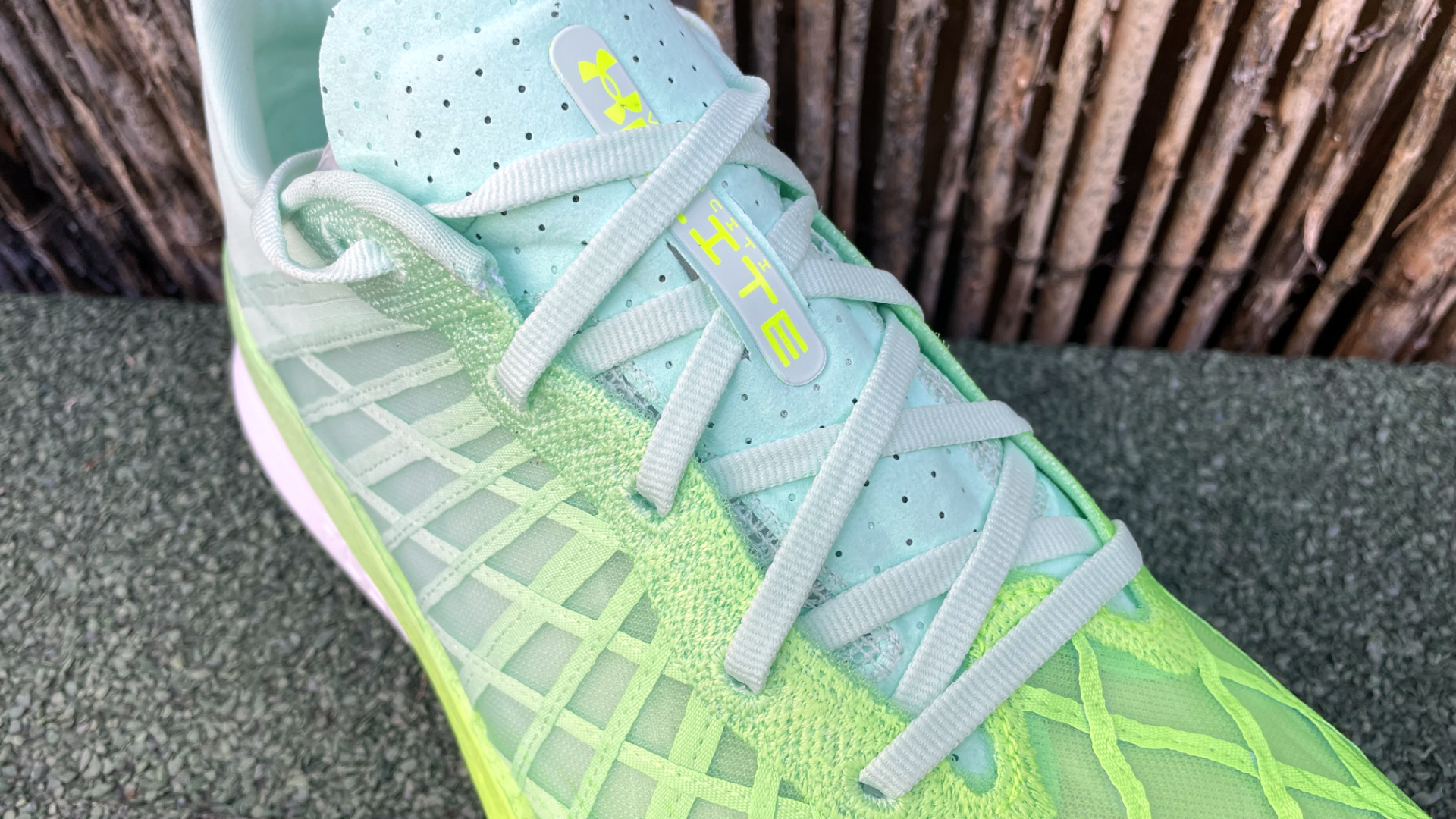Some like it firm: Under Armour Velociti Elite review
Despite being built for bossing marathons, the UA Velociti Elite performs best at racing shorter distances


Under Armour's first carbon race shoe, the Velociti Elite, is light, agile and nimble. It's a lot of fun over faster, shorter efforts, but it lacks the all-out punch – and some of the long-run protection – of its carbon rivals for going longer. The tech has a lot of potential, though, but right now, it's only good, not great.
-
+
Light and roomy fit
-
+
Excellent upper comfort
-
+
Good stability
-
-
Lacks punch of rivals
-
-
Runs a bit firm over longer miles
Why you can trust T3

When a company launches its first carbon-plate running shoe – and gives it to us to test before anyone else – it’s a big deal. So I’ve been busy laying down some big mileage to bring you this Under Armour Velociti Elite review.
The Under Armour Velociti Elite is designed for chasing 26.2-mile PBs. It steps into a very competitive space up against big hitters from Nike, Adidas and Saucony. I’ve run solo marathons, taken on tempo 10kms and blown my lungs on all-out 5kms to see if this marathon running shoe has what it takes to compete with the best running shoes in the business, especially those carbon plate-powered super shoes. Read on to find out.
Under Armour Velociti Elite review: Price and availability
The Under Armour Velociti Elite launched in March 2023. It’s available to buy from Friday, 7 April, at Under Armour UK and Thursday, 13 April, at Under Armour US for a recommended retail price of $250 / £225. That’s about standard for a carbon race shoe and puts it in the same ballpark as the Nike Vaporfly Next% 2 ($250 / £225), the Saucony Endorphin Pro 3 ($225/£210) and the Adidas Adizero Adios Pro 3 ($250 / £220).
It’s also £50 cheaper than the Nike Alphafly Next% 2 in the UK (only $25 cheaper in the US) and £60 cheaper than the new Saucony Endorphin Elite ($275/£280) in the UK. Other rivals to consider in the best carbon running shoes race include the ASICS Metaspeed Sky+ ($250/£225), the New Balance FuelCell SuperComp Elite V3 ($229 / £220) and the higher-stack Adidas Prime X Strung ($300 / £230).

Under Armour Velociti Elite review: What’s new?
As Under Armour’s first-ever carbon race shoe, everything is new with the Velociti Elite. Like the Saucony Endorphin Pro 3 and the New Balance Fuelcell Supercomp Elite V3, this shoe opts for a more streamlined look. As carbon-plate running shoes go, it’s compact with a subtle silhouette. It certainly doesn’t scream super shoe like the Nike Alphafly. That’s a good thing.
The design is a fairly familiar super-shoe story. There’s a big midsole stack (39mm / 31mm heel-to-toe) with an 8mm drop. The full-length carbon fibre plate is sandwiched between two midsole layers. Closer to your foot on top, there’s a cushioned-but-springy Pebax foam layer and a wedge of Under Armour’s new softer, lighter supercritical Flow foam underneath. Inside, there’s also a TPE sockliner to add a bit of extra cushioning, protection and bounce.
The outsole – or lack thereof – mimics the Under Armour Velociti Wind 2 daily trainers, saving weight by not having one. The supercritical Flow foam is durable and grippy enough, so there’s no need for extra rubber.
Get all the latest news, reviews, deals and buying guides on gorgeous tech, home and active products from the T3 experts
Up top, the Velociti Elite features a very light and minimal WARP 2.0 mesh upper with strategically placed horizontal tapes to enhance the support and structure. The tongue is lightly padded and perforated, and there’s a small amount of heel collar padding to boost comfort and heel hold. This is more traditional than the strategic cushion pads you’ll find in the Nike racers.
Under Armour Velociti Elite review: Weight
At 238g / 8.4oz in our UK men’s 8.5 test shoe, the Velociti Elite weighed in over the officially listed weight of 7.5oz / 212g. That puts it among the heavier carbon racers, closer to the Nike Alphafly and the Adidas Prime X Strung than the Nike Vaporfly or Adidas Adios Pro 3. For context, it’s carrying 20-30g more than the likes of the Adidas Adios Pro 3.

Under Armour Velociti Elite review: Fit
When it comes to fit, I ran in my regular size, UK 8.5, and I’d recommend going true to size. I found it easy to get a comfortable fit with reliable lace lockdown and good heel hold. The heel padding is balanced, comfortable and unfussy too. The Under Armour Velociti Elite has a racy feel, but it doesn’t hug as closely across the top of the foot as many carbon race shoes. It’s much roomier than the Alphafly or the New Balance Supercomp Elite, for example, and there’s a decent amount of toe box wiggle room, too. No black toe-nail troubles here after the marathon test.
Under Armour Velociti Elite review: Running performance
In testing, I ran more than 100 miles in the Under Armour Velociti Elite, including a 3.5-hour solo marathon test (mixing up the miles from easy to marathon pace). I also clocked some 10-mile efforts (mixing slower and faster miles), a handful of tempo 10kms and some all-out 5kms to test the top speed.
Comfort on the foot is great. The shoes disappear nicely and let you get on with business. From the moment you lace up the Velociti Elite, they’re noticeably firmer, less springy and energetic underfoot than many rival carbon shoes. There’s much more subtle spring, and though they’re still lively, they’re also much more direct. If you prefer more ground feel, that’s a good thing. If you’re hoping for the same ping as the top Nike and Adidas racers, it’s not quite there.
This is undoubtedly a shoe that runs best at faster paces when you’re moving with your best locked-in form. The firmness actually encourages a faster foot turnover, and the transitions are snappy enough, but it lacks that crucial bit of kick that you get from the Alphafly. It’s lacking that helpful boost that delays fatigue deep into those 2-hour plus runs.

The firmness told over the marathon distance, too. Even as a fan of firmer-ride shoes, I found my feet took a lot of impact later into my 26.2 test. I ran a 3:30 marathon, and I found I wanted a little more cushioning – and a little more propulsion – in the last hour. I’m not sure they offer the protection most runners will look for deep into the marathon miles.
However, there’s a flip to that. What you lose in spring, you gain in stability. The Velociti Elite offers a brilliantly reliable platform to run off. You’re much more connected to the road underfoot than in some of the softer, wobblier super shoes. And even if there’s not the extra energy you find in some rival carbon shoes, that stable platform is very welcome when your form goes ragged.
I enjoyed the Under Armour Velociti Elite most over shorter, faster distances. It was happiest on tempo 10kms and guns-blazing 5kms where that lack of cushioning matters less. If you’re someone who races 5kms, you’re probably choosing a lighter shoe, but if you mix up your efforts in training, this has good range.
It’s closer to a less-cushioned Saucony Endorphin Pro 3 than a Nike Alphafly, and although Under Armour pegs it as a marathon PB chaser, I think the more subtle ride boosts its daily training potential. In fact, its real strength might just be as a fast daily trainer rather than a PB-chasing marathon race shoe.
Under Armour Velociti Elite review: Durability and value
A quick word on value. At £220 / $250, the Under Armour Velociti Elite sits on the premium shelves with the priciest running shoes. And though it lacks the all-out punch of some rivals, that might be a hidden strength. Of all the carbon super shoes, this feels built to cope with higher mileage, and the stability and subtle spring also make this a shoe you can use more readily for training as well as racing. That versatility gives it some daily trainer and short-distance racer vibes that could add up to good value if you’re only looking to invest in one shoe.

Under Armour Velociti Elite review: Verdict
There are plenty of positives for the Under Armour Velociti Elite – good uppers, comfortable fit and great stability. It’s light, agile and nimble, easy and fun to run in, over most distances. But if you’re looking for the punchiest marathon race shoe, this isn’t it.
The firmer, supercritical Flow foam lacks the lively propulsive ride we’ve come to expect in the best carbon-plate marathon racers, and the firmer ride definitely won’t be to everyone’s liking. Particularly at mile 22 of a marathon.
This shoe is much better suited to shorter, faster runs or for anyone looking for a more direct, more stable, subtle super shoe option. For me, it’s another Under Armour running shoe that drops into the ‘good, not great’ category. But when it inevitably drops in price, it could be a great shoe to add to your rotation.
Under Armour Velociti Elite review: Also consider
The Saucony Endorphin Pro 3 is another excellent race shoe that probably offers the most comparable ride to the Velociti Elite. But it’s a bit more cushioned and protective over longer miles.
If you like your carbon races shoes light, minimal (for a super shoe) and more direct, then the Nike Vaporfly Next% 2 (or the new Vaporfly Next% 3 when they’re on sale) is another option. With lightweight uppers, a roomier toe box and a lower stack of ZoomX foam than the Alphafly, it’s racier than the Velociti Elite and remains one of the most popular shoes for chasing half and marathon PBs.
If you want all-out speed, the best marathon race shoe in the business is still the Nike Alphafly Next% 2. The mix of lightweight, race-hugging uppers, a big stack of ZoomX foam and Zoom Air pods in the midfoot make for a winning top-pace combination over the 26.2 distance.

Kieran is a freelance writer and editor working in the space where health, fitness, sports and technology collide. He covers everything from virtual reality and smart scales to the latest wearable health trackers. Kieran is also a borderline-obsessed runner and is passionate about using the latest technology to hack his health in search of marginal gains.